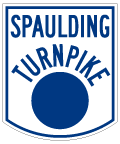


The Spaulding Turnpike travels 33.2 miles north from Portsmouth (U.S. 1 Bypass) to NH 16 (White Mountain Highway) in north Milton. The entire limited access route doubles as NH 16, with sections between Exits 6 and 7 in Dover and Exits 9 and 12 in Rochester tolled.
Spaulding Turnpike Guides
The Spaulding Turnpike was approved by the state Legislature in 1953 as the Eastern Turnpike. It was to run north from Portsmouth Circle, where the New Hampshire Turnpike ended, to Dover, Rochester and eventually the Lakes Region. Initial work took place on a five mile section from Portsmouth north to Exit 6 near Dover Point. The turnpike incorporated the 19342 built General Sullivan Bridge across Little Bay, which carried just two lanes at the time. Opened on Oct. 3, 1956,2 this section of the Spaulding Turnpike was toll free and doubled as U.S. 4. Two at-grade elements of the road included a railroad crossing and intersection with Gosling Road (now Exit 1) for then Pease Air Force Base.1
Work ensued on 17 miles of new roadway taking the Spaulding Turnpike north from Exit 6 to U.S. 202 & NH 11 (Highland Street) and NH 125 (Milton Road) in Rochester. This was completed on August 29, 1957,2 with four lanes between Exits 6 and 12 (NH 125) and two lanes to U.S. 202 (former Exit 17) with the provision for future expansion.1 Exit 10 was not assigned and reserved for a proposed east-west turnpike from Dover to Interstate 393 at Concord. This was later dropped with completion of the NH 101 freeway between Manchester and Hampton.1
A 12 mile northern extension for the Spaulding Turnpike was announced in 1973. This redirected the turnpike from its end at U.S. 202 & NH 11 and 125 on a new alignment northward to Milton and NH 16 (White Mountain Highway) near Laskey Corner and Union. The new road was proposed as a super-two expressway with 12 foot travel lanes and 10 foot outside shoulders within a 325 foot right of way. Work between 1978 and 1981 also included the construction of a new partial cloverleaf interchange (Exit 16) with the old alignment east to U.S. 202.1
Subsequent improvements to the Spaulding Turnpike included adding a second span across Little Bay to expand the freeway to four overall lanes in 1966. The additional span carried northbound traffic until 1984, when another new bridge was built to replace the original General Sullivan Bridge, which was retained for non-motorized traffic.1 Closure of Pease Air Force Base as a military facility in 1991 allowed NHDOT to upgrade the at-grade intersection with Gosling Road and the former base entrance into an interchange. The new exit was completed in 1993 in conjunction with the removal of the nearby railroad crossing.1
Widening of the turnpike from Newington to Dover was studied as early as 1990 and again from 1997 onward. This led to a Record of Decision by the FHWA in May 2008 approving the $260 million project to expand the freeway between Exit 1 to just north of Exit 6. Work kicked off in 2010 runs through 2020.1 The Spaulding Turnpike Newington-Dover Project encompasses widening the 3.5 mile stretch to six overall lanes with auxiliary lanes added between Exits 3 and 6. Construction also eliminates Exits 2 and 5 and redesigns Exits 3, 4 and 6 to full access interchanges.
Further north $177 million widening of the Spaulding Turnpike in Rochester ran from February 2008 and 2012. This expanded a 5.2 mile section between Exits 12 and 16 from a super-two into four lane roadway with separate carraigeways.1
- "Creation of Spaulding Turnpike began in 1950." Foster's Daily Democrat (Dover, NH), December 14, 2014.
- "N.H. TURNPIKE TIMELINE." Telegraph, The (Nashua, NH), August 21, 2005.
Connect with:
Interstate 95 - Blue Star Turnpike
U.S. 4
Route 16
Page Updated 02-20-2015.
